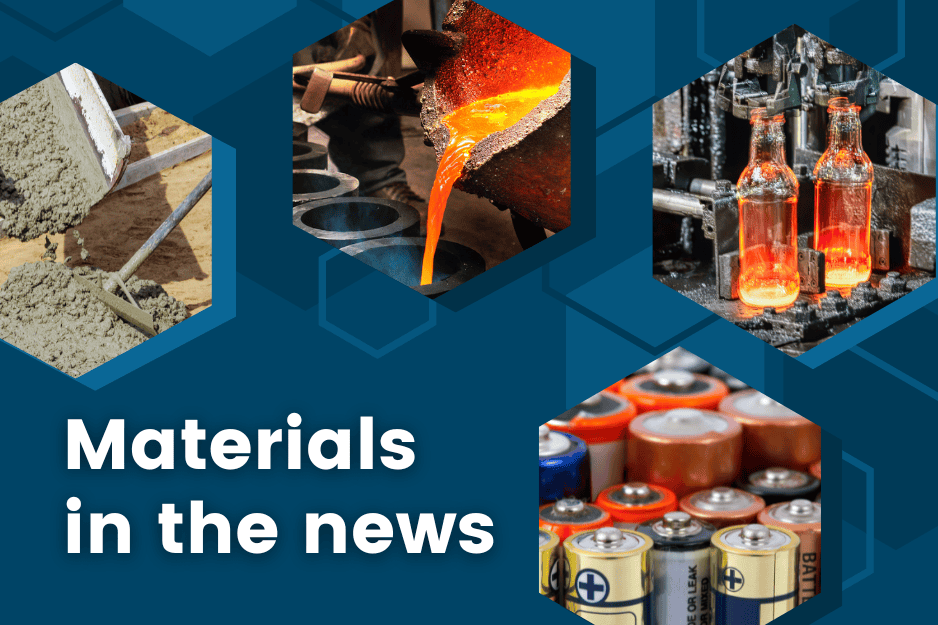
[Image above] Credit: ACerS
NANOMATERIALS
Researchers develop new methods to generate and improve magnetism of 2D materials
Florida State University researchers made two breakthroughs in producing iron germanium tellurium: a collection method that yields 1,000 times more material than typical practices, and the ability to alter the material’s magnetic properties through a chemical treatment.
Scientists learn how to make nanotubes that point in one direction
Researchers from Tokyo Metropolitan University used chemical vapor deposition to make tungsten disulfide nanotubes that point in the same direction when formed. Their technique resolves the long-standing issue of jumbled orientations in collected amounts of nanotubes.
ENERGY
Existing EV batteries may last up to 40% longer than expected
Researchers at Stanford University and SLAC National Accelerator Laboratory determined that the batteries of electric vehicles subject to the normal use of real-world drivers could last about a third longer than generally forecast.
Toward safer, higher performance batteries through network topology optimization
Researchers led by Tokyo University of Science used reverse Monte Carlo modeling to investigate the atomic structure and effect of network structure on the electrode properties of TiNb2O7. They found that reducing the particle size by ball milling and subsequent heat treatment relaxed structural distortion and improved charging/discharging capabilities.
Porous silicon oxide electrodes could fix durability issues in solid-state batteries
Doshisha University researchers showed that highly porous silicon oxide electrodes offer much better cycling performance compared to nonporous silicon oxide electrodes, which crack and peel when the electrode expands and contracts during charging and discharging.
Concentrated solar thermal energy system deploys graphene nanoparticles in glass tubing
PROMES-CNRS researchers developed a concentrated solar thermal energy system that uses graphene nanoparticles dispersed in water and carried in glass tubing instead of metal so it can absorb both heat and light. A preliminary pilot study allowed them to verify the feasibility of the collector and find the key points affecting its performance.
BIOMATERIALS
Nanoceramic ‘stars’ deliver therapy into the skin
Empa researchers are working with industry partner Aldena Therapeutics to develop nanoceramic “stars” made of aluminum oxide that deliver therapeutically active molecules into the skin.
Miniaturized brain pressure sensing device enabled by all-glass package
New Zealand start-up Kitea Health has developed the world’s first miniaturized brain pressure sensing device, which was first implanted in a human brain in June 2024. The device was made possible through a collaboration with SCHOTT Primoceler Oy, whose Proteon all-glass package allowed the implant to be miniaturized to an unprecedented size.
ENVIRONMENT
Enabling a circular economy in the built environment
Massachusetts Institute of Technology researchers assessed how to spur widespread circular transition within the built environment by considering stakeholders’ perceptions of circularity and quantifying their willingness to pay.
Scientists develop 3D concrete printing method that captures carbon dioxide
Nanyang Technological University researchers developed a 3D concrete printing method that captures carbon. The process involves injecting steam and CO2, captured as the byproducts of industrial processes, into the mixing concrete, which then directly incorporates and stores the CO2 in the concrete structure.
Mapping molecular arrangements to pave the way for better catalytic systems
Researchers at The Pennsylvania State University identified how chemical catalysts drive the creation of liquid fuels from sunlight, paving the way for more efficient removal of greenhouse gases from the atmosphere.
OTHER STORIES
Students: Register for São Carlos School on Glasses and Glass-ceramics by December 20
The São Carlos Center for Research, Technology, and Education in Vitreous Materials is organizing the third São Carlos School on Glasses and Glass-ceramics from March 10–15, 2025, in São Carlos, Brazil. The school has no registration fee and offers some student grants. The deadline to apply is Dec. 20, 2024.
How a Swedish town is reigniting passion for salt-glazed ceramics
Höganäs, a Swedish town once famous for its salt-glazed ceramics, is having a renaissance. A Travel + Leisure article reports on this rebirth.
Author
Lisa McDonald
CTT Categories
- Weekly Column: “Other materials”